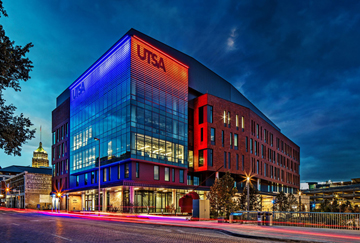In creating a building befitting of the cutting-edge, high-tech research and cyber security programs taking place at the University of Texas at San Antonio (UTSA) National Security Collaboration Center, a combination of red brick, limestone masonry, metal and high-performance glass were selected for the modern façade.
The mix of materials helps the building fit within the historic context of downtown San Antonio with Solarban® 70 glass from Vitro Architectural Glass enhancing indoor-outdoor connections.
“We have utilized Solarban® 70 glass on numerous projects and it has been a time-tested solution,” said Adam Bush, AIA, president, Overland Partners, San Antonio, Texas. “For this project, it was determined to be a high-value option as we weighed requirements for building performance, aesthetic criteria and overall cost.”
Solarban® 70 glass is the most commonly specified triple-silver-coated low-e glass in the industry. With its transparent, colour-neutral aesthetic and unprecedented solar control and visible light transmittance (VLT), Solarban® 70 glass offers the perfect balance between form and function. When coupled with conventional clear glass in a one-inch insulating glass unit (IGU), Solarban® 70 glass provides a solar heat gain coefficient (SHGC) of 0.27 and VLT of 64%.

As the new home for the School of Data Science, the building houses its cybersecurity, cloud computing, data and analytics and artificial intelligence programs in addition to the National Security Collaboration Center (NCSS)—ranked as the number one cybersecurity program in the nation by the Ponemon Institute.
Supporting a range of public spaces and the quiet and intimate settings required of a security institution, the Overland Partners designed the building with curtain wall and punched window openings based on programmatic needs and the sun’s orientation.
The windows range between 2 by 8 feet, 8 inches and 4 by 8 feet, 8 inches, and were calibrated to minimize heat gain and glare. For enhanced daylight, glare control and privacy, a combination of motorized and manual roller shades were installed throughout the façade.




